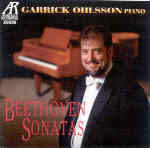The first thing you notice about these performances is the dark, registrally differentiated timbres of Garrick Ohlsson’s Bösendorfer grand piano. Listeners steeped in recorded Beethoven sonata lore will recognize its singular sonority from some of Wilhelm Backhaus’ 1960s-vintage Beethoven releases. Either by chance or design, Ohlsson shares that veteran pianist’s propensity for ruddy, massive textures and rhetorical freedom–qualities also associated with Daniel Barenboim’s EMI Beethoven cycle. While Ohlsson is more scrupulous than Backhaus or Barenboim in regard to Beethoven’s quirky subito dynamics, he seems curiously out of sync with the music’s nervous energy and ardent drama. He treads ponderously through the Op. 109 sonata’s first two movements, which lack the flow and inner urgency Claudio Arrau, Annie Fischer, Freddy Kempf, and Richard Goode bring to the music. Op. 2 No 1’s slow movement stands out for its warm, singing cantible, although Ohlsson turns in a heavy-footed, static Menuetto and makes less of the outer movements’ forward drive than the leaner, more febrile Goode, Perahia, and Richter recordings.
The Appassionata, however, brings out Ohlsson’s big-boned, theatrical instincts at their most authentic. He keeps the first movement’s cross-register imitative sequences in perfect perspective alongside the repeated E-flat triplets, and builds the Finale’s coda to a grand climax without giving in to rushing for effect. Although Ohlsson’s Appassionata may lack the kinetic power of Brendel’s digital remake, the urbane elegance of Rubinstein’s classic stereo version, or Rudolf Serkin’s gaunt propulsion, its virtues sustain repeated hearings. Too bad the engineering is relatively murky and harsh at loud junctures–in contrast to the pellucid clarity found on other Ohlsson Arabesque recordings such as the Debussy Etudes and Chopin Mazurkas.
































